- News
- Reviews
- Bikes
- Components
- Bar tape & grips
- Bottom brackets
- Brake & gear cables
- Brake & STI levers
- Brake pads & spares
- Brakes
- Cassettes & freewheels
- Chains
- Chainsets & chainrings
- Derailleurs - front
- Derailleurs - rear
- Forks
- Gear levers & shifters
- Groupsets
- Handlebars & extensions
- Headsets
- Hubs
- Inner tubes
- Pedals
- Quick releases & skewers
- Saddles
- Seatposts
- Stems
- Wheels
- Tyres
- Tubeless valves
- Accessories
- Accessories - misc
- Computer mounts
- Bags
- Bar ends
- Bike bags & cases
- Bottle cages
- Bottles
- Cameras
- Car racks
- Child seats
- Computers
- Glasses
- GPS units
- Helmets
- Lights - front
- Lights - rear
- Lights - sets
- Locks
- Mirrors
- Mudguards
- Racks
- Pumps & CO2 inflators
- Puncture kits
- Reflectives
- Smart watches
- Stands and racks
- Trailers
- Clothing
- Health, fitness and nutrition
- Tools and workshop
- Miscellaneous
- Buyers Guides
- Features
- Forum
- Recommends
- Podcast
TECH NEWS
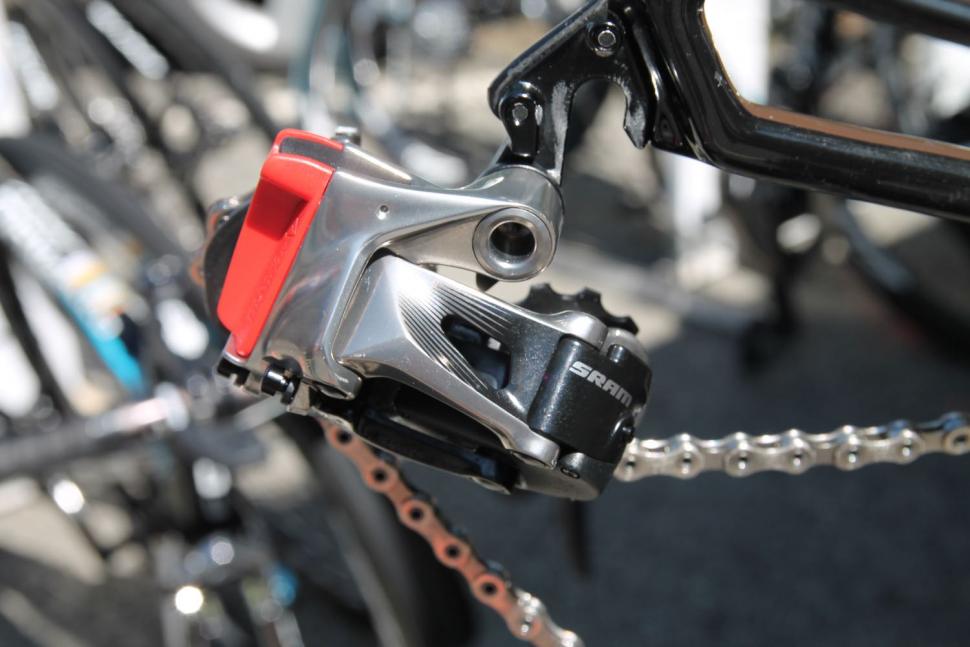 SRAM Wireless - 11 (1)
SRAM Wireless - 11 (1)SRAM’s wireless groupset spotted - massive photo gallery
It’s no secret that SRAM has been working on a wireless electronic groupset. We first saw it on bikes at the Tour of California last year, and it’s been spotted on numerous occasions since.
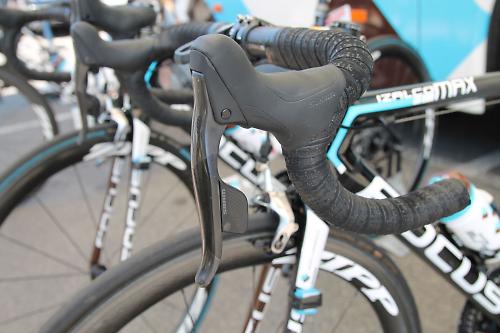
I was at the start and finish of the final stage of the Route du Sud today in the beautiful south of France (and the weather is lovely by the way) and several of the AG2R Focus team bikes were equipped with the new wireless groupset.
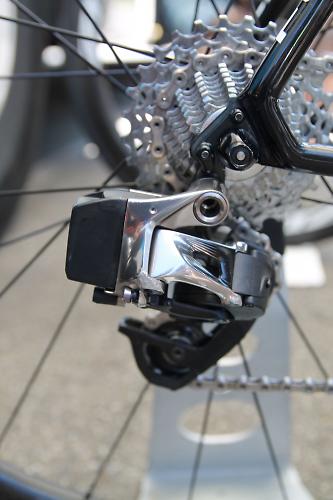
This is the first time I’ve seen the new groupset in the flesh. Looking at it this closely, one thing is very much clear: it looks ready for production. From the graphics on the rear mech, embossed SRAM logos and the ‘Red’ logo on the carbon fibre brake levers obscured only by a strip of black electrical tape, it’s clear the parts aren't at the prototype stage and are being properly manufactured.

Few details have emerged about the new groupset. SRAM is remaining tight-lipped until it decides to officially unveil it, most likely at the Tour de France. One aspect of its functionality was revealed while I watched the mechanics wash and clean the bikes after the stage.
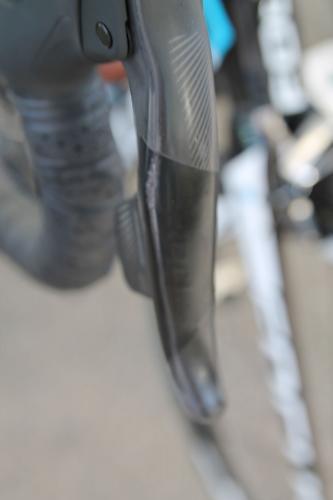
The batteries, the large black plastic units hanging off the back of each mech, are removable. That much was easy to deduce from early photos, but I actually watched a mechanic remove the batteries. And it’s very simple. A clip on the top flips up, the battery pops off, and a red plastic blanking plate is installed to protect the metal contacts while the bike is washed.
.jpg)
The red plastic cover protects the contacts when the battery is removed for charging
One obvious advantage of the removable batteries is that you don’t have to store your bicycle near a mains power supply, as you do with Di2. I would imagine SRAM has developed its own dock to charge the batteries. It’s not clear how long the batteries last, but combined the two batteries appear the about the same size as a Shimano battery.
.jpg)
With the battery removed, exposing the metal contacts
Despite the clear readiness of these components, SRAM seems to be keen to get as many race miles as possible logged on the groupset, which is why it’s been spotted at so many races in the last year. SRAM clearly doesn’t want a repeat of the hydraulic disc brake recall. There aren't as many teams using SRAM as a few years ago, but there’s an increasing number of AG2R racers on the new groupset, so it’s slowly being rolled out. We’d expect to see the entire team on the wireless groupset at the Tour de France.
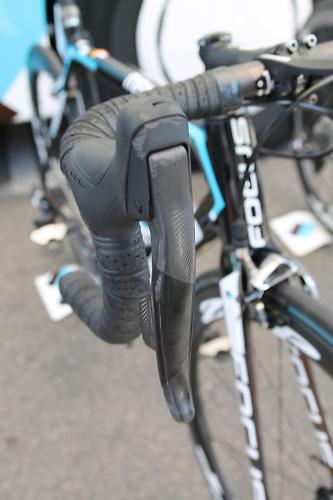
The components in AG2R's bikes have clearly been getting plenty of use; just look at all the scrapes and scratches. That suggests the groupset can handle the odd knock and crash, which bodes well for its launch. Parts used by the pros need to be reliable and tough.
.jpg)
SRAM's wireless group doesn't appear to have a similar central control module. That's different from Shimano’s Di2 which uses a control module, commonly mounted under the stem, which is used to charge the battery and also to set up the indexing and to make indexing changes during riding. It’s not clear how SRAM's transmission is first set up when installed on a bike, or how changes are made if the indexing gets knocked out of alignment, say following a crash.
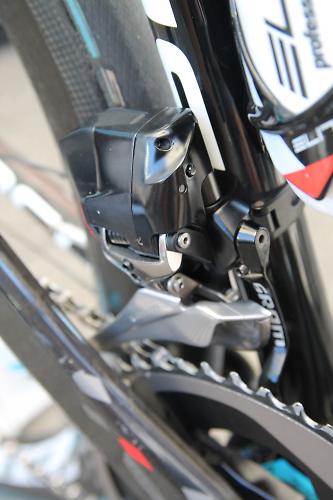
Related story: SRAM's wireless shifting—a saboteur's dream?
The shape of lever hoods don’t appear dramatically different to regular RED mechanical shifters, but the pointy bit is a bit more, well, pointy, suggesting SRAM has managed to package the electronic gubbins more compactly than its hydraulic brake levers.
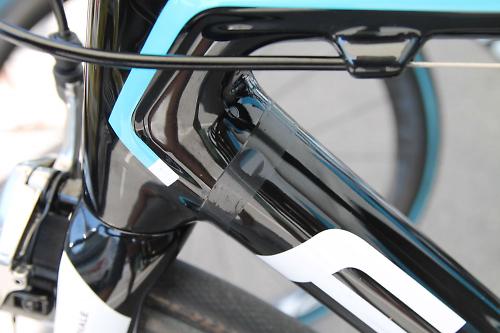
This frame has the Di2 ports taped over because, with no wires, they’re redundant.
David worked on the road.cc tech team from 2012-2020. Previously he was editor of Bikemagic.com and before that staff writer at RCUK. He's a seasoned cyclist of all disciplines, from road to mountain biking, touring to cyclo-cross, he only wishes he had time to ride them all. He's mildly competitive, though he'll never admit it, and is a frequent road racer but is too lazy to do really well. He currently resides in the Cotswolds, and you can now find him over on his own YouTube channel David Arthur - Just Ride Bikes.
Latest Comments
- hawkinspeter 1 hour 33 min ago
Yul Brynner was a lifelong liverpool fan who didn't wear aftershave <singing> Yul never wore cologne </singing>
- dh700 2 hours 30 min ago
Unfortunately for you, you previously claimed, back on page 1, "Average distance ridden by American cyclists per year, less than 50km." Per...
- mark1a 3 hours 30 min ago
They almost certainly will; back in 2022, here in Dorset, we were due to host stage 7 of the Tour of Britain, and for the months preceding, the...
- mdavidford 3 hours 46 min ago
The way back ones don't count - he said 'in the last 20 years' (presumably the cycling equivalent of 'in the Premier League era') so it's only 2007...
- whosatthewheel 4 hours 10 min ago
Only mugs buy anything for the full retail price these days. They will soon be reduced to 299, just like the 1st gen. which went from 375 to 199 in...
- Bmblbzzz 5 hours 11 min ago
How is it only an extra 56 minutes a day? That seems to imply either the road is very busy with vehicles, in which case it might not be delivering...
- KiwiMike 5 hours 21 min ago
I've lived in Perthshire for seven years. You really should stay abreast of NZ politics - believe me, Scotland is a beacon of properiety in...
- Rendel Harris 5 hours 48 min ago
"Gloucestershire Live" headline on Facebook...you actually have to open the story to discover a car was involved and he didn't just misjudge a bend...
- leedorney 6 hours 17 min ago
Next min we'll be hearing he's related to Ursula Von Der layen
- leedorney 6 hours 19 min ago
The UCI bores strike again... once done a 1/2/3 cat race and even then then where truly unrelentless
Add new comment
50 comments
I have multiple Garmin heart rate straps and GSC10's, never had a problem with any of them.
I always use good quality, branded batteries (inc IKEA) and wash the heart rate straps regularly as instructed.
Do electronic gear shifters interfere with pacemakers ? ?
ANT+ for a garmin display and data download giving time/distance/watts/speed0 from a gear combo used?
No, pacemakers don't depend on wireless, so the itty bitty transmissions from SRAM wouldn't interfere with them. To properly shut down an pacemaker would require a very large EMP to create a big current in the pacemaker and fry it. The kind of EMP created by a nuclear detonation or EMP bomb.
Do they use these EMP thingys in airport customs then ? Or security beams in ASDA for eg ? Or indeed heart rate monitors because these are all likely to affect my pacemaker !
Perhaps somewhat surprisingly some pacemakers have a wifi interface, and in some cases it can be hacked: http://www.wired.com/2008/03/scientists-demo/
So it's not completely beyond belief to think that SRAM's kit could have an effect, although I'd say it's fairly unlikely - after all if a pacemaker were that delicate any wifi router or smartphone would present a serious risk...
Nearly all modern pacemakers are re-programmable by wireless (although not always wi-fi protocols).
Usually the communications "head unit" that can "talk to" the implanted unit has to be held against the chest, because the comms is very, very short range.
As a previous commenter stated, nothing coming out of a bicycle groupset can affect such an implant. That is not to say that pacemakers cannot be "jammed", just that your sexy new SRAM stuff will not do it.
I have guven up on garmin cr2032 addons. The gsc10 is great for about 2 months, if you dont lose the magnets. They are terrible for batteries, and for leaking.
The HRMs that came with my 305 and 310 (x2) lasted less than 6 months each. And the number of new batteries I bought only to find the unit was knackered not just out of juice is ridiculous. The current one with my 910 seems to be lasting a bit better but the software on the 910 unit itself is terrible.
So no issue with battery power per se, but the manufacturers implementation.
A battery's a battery. As long as the contact works and it's not duff from the off, I can't see that being an issue.
I have 2 lights working on CR2032, one works, one doesn't. Same manufacturer. Could be USB connection and still have a dodgy charge/connection. Don't think the fact it's a battery should be a barrier.
Also have the premium Garmin HRM and that's never missed a beat....(cymbals)
"The shape of lever hoods don’t appear dramatically different to regular RED mechanical shifters, but the pointy bit is a bit more, well, pointy, suggesting SRAM has managed to package the electronic gubbins more compactly than its hydraulic brake levers." Is compactly a word? Anyway, for their next trick they need to integrate the hydro master cylinder into the lever and then they can stop for a cup of tea and a piece of cake.
Indeedy.
I always feel left out and in the minority when I say I have never had an issue with any coin cell powered Garmin device.
Mind you I haven't used the premium HRM strap I have but it doesn't look all that different from the Polar one I used to own.
I once had a wireless VDO computer that used to cease functioning when I went under the overhead electrical cables near to my old house. As soon as I was away from them, it started working again.
I wonder if a system such as this would be affected in the same way? it does look very tidy compared to the Shimano & Campag systems currently out.
How long until Shimano develops a jammer?
In about 20 years or so the marketing blurb will be something like this: We have developed a new gear mechanism that is lighter, easier to maintain, more reliable, cheaper and does not require you to be constantly charging batteries. We will use a simple cable mechanism, no fuss, easy to set, no let downs and half the price. Why we never thought of this before is a mystery.
Knowing Shimano, they'll already have a wireless group testing but they have a better secrecy policy than SRAM.
I'd still rather ride a Di2 wired set up than wireless from SRAM especially if both levers have to be pressed to change at the front.
My source says it's going to be available next spring as well as XD driver 11-speeed road wheels that go down to a 10t small cog.
Why don't they just develop electronic legs !
This looks great, and I love the idea of no wires/cables to the mechs.
My one concern, is that I don't see any way to adjust or fix things if it goes wrong. I guess my four Shimano groups I've had over the last fifteen years and tens of thousands of km's have never 'gone wrong', so why should this be any different? I just see that something won't work quite right, and the LBS mechanic will only be able to say ''...we need to replace the whole rear mech...'' ... much like you get at the car dealer these days ... nobody can fix anything, they just replace whole modules.
Still, next bike will likely be electronic shifting without wires and with hydro disc brakes ...
I want one. Shame it will be a decade before it's affordable for most of us!
One downside to the development of electronic shifting is that it will reduce the research and development of cable shifting.
I would much prefer that cable shifting is taken to its ultimate state, rather than leaving it for electronic stuff.
The latest Shimano stuff is very, very good and I would be keen to see how good it could become.
I'm sure that in 5 years or so we will all be on electric shifting, but there is something to be said for the ability to fettle things without a plug and a computer.
Well Shimano doesn't seem to have stopped developing mechanical groupsets, but using the latest Dura-Ace groupset, which is simply stunning, it's hard to see how it can be improved, but I'm sure they'll find a way
Well, they've already turned it up to 11, so it's hard to see where it can go from here.
I'm with you. Although I've only tried Di2 and not EPS, I'm on mechanical 2015 Chorus on my 'good' bike and think it's sublime, I have absolutely no complaints about the 2014 Veloce on my steel steed either. The way they perform, especially Chorus leaves me failing to understand why I need electronic shifting. The handful of Di2 rides I've had does nothing to convince me.
Perhaps the battery was removed for re-charging as part of their maintenance workflow?
EDIT - if a plastic cap can seal the electronics, then there is no reason why the plastic cap on the battery cannot perform the same job...
I agree, it seems pretty obvious that the batteries would come off for a charge whilst the bike was checked and washed.
"Still it's better than Di2 or mechanical"
Given that it isn't actually for sale yet, I think that conclusion maybe somewhat premature.
Time will tell.
That would seem to suggest 4 batteries to check and 4 sets of potential interfaces to go wrong.
I like the idea of innovation but I'd be leaving it for a couple of years while the world's cack handed spanner monkeys put it through some real beta testing.
Interesting to note that the UK is considered one of the most testing places for mountain bike equipment; let's see how this performs over the year in Huddersfield rather than Los Angeles.
Whilst I'm sure we will see it on X1 in due course I don't think it's entirely fair to subject this to off road just yet!
Still it's better than Di2 or mechanical. In Di2 you have even more contact points because of the central unit, while in any wired system (both mechanical or electronic) you also have a cable which can be damaged.
Pages